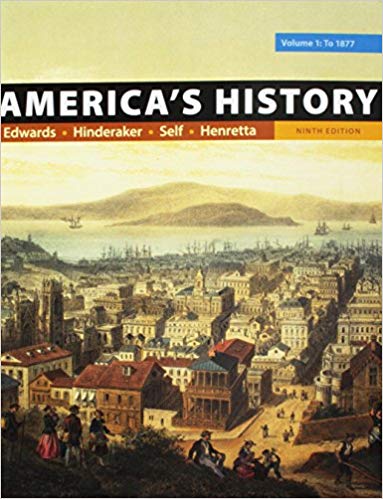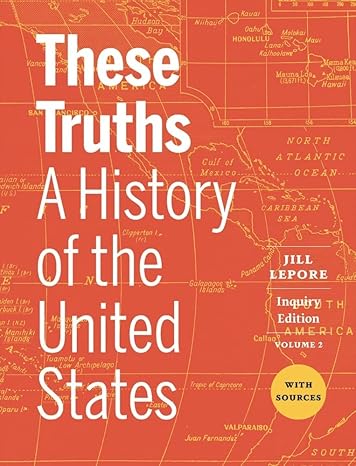Known for its clear, insightful analytical narrative and balanced approach, America's History brings America's diverse past to life. An accessible and balanced narrative with built-in primary sources and skills-based pedagogy gives students practice in thinking historically.
چکیده فارسی
تاریخ آمریکا که به دلیل روایت تحلیلی روشن، روشنگر و رویکرد متعادل خود شناخته شده است، گذشته متنوع آمریکا را زنده می کند. یک روایت قابل دسترس و متعادل با منابع اولیه داخلی و آموزش مبتنی بر مهارت به دانشآموزان در تفکر تاریخی تمرین میکند.
ادامه ...
بستن ...
Ebook details:
عنوان: America's History, Volume 1 (9781319060602) Rebecca Edwards, Eric Hinderaker, Robert O. Self, James A. Henretta
نویسنده: Books
ناشر: Bedford/St. Martin's; Ninth edition (September 1, 2017)
زبان: English
شابک: 1319060609, 978-1319060602
حجم: 219 Mb
فرمت: Epub
ادامه ...
بستن ...
Front Matter
Cover
Take the lead in succeeding in your history course.
Avoiding Plagiarism and Managing Sources
About the Cover Image
U.S. Map
World Map
Half-title Page
Title Page
Copyright Page
Preface: Why This Book This Way
Versions and Supplements
Brief Contents
Contents
Maps, Figures, and Tables
Special Features
Part 1 Transformations of North America, 1491–1700
Chapter 1: Colliding Worlds, 1491–1600
The Native American Experience
The First Americans
American Empires
Chiefdoms and Confederacies
The Mississippi Valley
Eastern Woodlands
America in Global Context: Altered Landscapes
The Great Lakes
The Great Plains and Rockies
The Arid Southwest
The Pacific Coast
Patterns of Trade
Interpretations: How Connected Were Native American Communities Before 1492?
Sacred Power
Western Europe: The Edge of the Old World
Hierarchy and Authority
Peasant Society
Expanding Trade Networks
Myths, Religions, and Holy Warriors
The Rise of Christianity
The Crusades
The Reformation
West and Central Africa: Origins of the Atlantic Slave Trade
Empires, Kingdoms, and Ministates
Trans-Saharan and Coastal Trade
Thinking Like a Historian: Colliding Cultures
The Spirit World
Exploration and Conquest
Portuguese Expansion
The African Slave Trade
Sixteenth-Century Incursions
Columbus and the Caribbean
The Spanish Invasion
Analyzing Voices: A Spanish Priest Criticizes His Fellow Colonists
Cabral and Brazil
Summary
Chapter 1 Review
Terms to Know
Review Questions
Making Connections
Key Turning Points
Chapter 2: American Experiments, 1521–1700
Spain’s Tribute Colonies
A New American World
The Columbian Exchange
The Protestant Challenge to Spain
Plantation Colonies
Brazil’s Sugar Plantations
England’s Tobacco Colonies
The Jamestown Settlement
Thinking Like a Historian: Who Was Pocahontas?
The Indian War of 1622
Lord Baltimore Settles Catholics in Maryland
The Caribbean Islands
Plantation Life
Indentured Servitude
Interpretations: What Role Did Climate Play in American Colonization?
African Laborers
Neo-European Colonies
New France
America in Global Context: Plantation Colonies Versus Neo-Europes
New Netherland
The Rise of the Iroquois
New England
The Pilgrims
John Winthrop and Massachusetts Bay
Roger Williams and Rhode Island
Anne Hutchinson
Puritan-Pequot War
The Puritan Revolution in England
Analyzing Voices: Susanna Martin, Accused Witch
Puritanism and Witchcraft
A Yeoman Society, 1630–1700
Instability, War, and Rebellion
Native American Resistance
Metacom’s War, 1675–1676
The Pueblo Revolt
Bacon’s Rebellion
Frontier War
Challenging the Government
Summary
Chapter 2 Review
Terms to Know
Review Questions
Making Connections
Key Turning Points
Part 2 British North America and the Atlantic World, 1607–1763
Chapter 3: The British Atlantic World, 1607–1750
Colonies to Empire, 1607–1713
Self-Governing Colonies and New Elites, 1607–1660
The Restoration Colonies and Imperial Expansion
The Carolinas
William Penn and Pennsylvania
From Mercantilism to Imperial Dominion
The Navigation Acts
The Dominion of New England
The Glorious Revolution in England and America
Rebellions in America
Imperial Wars and Native Peoples
Tribalization
Indian Goals
Analyzing Voices: Native Americans and European Empires
The Imperial Slave Economy
The South Atlantic System
England and the West Indies
The Impact on Britain
Africa, Africans, and the Slave Trade
Africans and the Slave Trade
The Middle Passage and Beyond
America in Global Context: Olaudah Equiano: The Brutal “Middle Passage”
Slavery in the Chesapeake and South Carolina
Interpretations: Why Did Americans Adopt Slavery?
An African American Community Emerges
Building Community
Thinking Like a Historian: Servitude and Slavery
Resistance and Accommodation
The Stono Rebellion
The Rise of the Southern Gentry
White Identity and Equality
The Northern Maritime Economy
The Urban Economy
Urban Society
The New Politics of Empire, 1713–1750
The Rise of Colonial Assemblies
Salutary Neglect
Protecting the Mercantile System
Mercantilism and the American Colonies
Summary
Chapter 3 Review
Terms to Know
Review Questions
Making Connections
Key Turning Points
Chapter 4: Growth, Diversity, and Conflict, 1720–1763
New England’s Freehold Society
Farm Families: Women in the Household Economy
Thinking Like a Historian: Women’s Labor
Farm Property: Inheritance
Freehold Society in Crisis
Diversity in the Middle Colonies
Economic Growth, Opportunity, and Conflict
Tenancy in New York
Conflict in the Quaker Colonies
America in Global Context: Transatlantic Migration, 1500–1760
Cultural Diversity
The German Influx
Scots-Irish Settlers
Interpretations: Did Diversity Lead to Toleration?
Religion and Politics
Commerce, Culture, and Identity
Transportation and the Print Revolution
The Enlightenment in America
The European Enlightenment
Franklin’s Contributions
American Pietism and the Great Awakening
New England Revivalism
Analyzing Voices: Evangelical Religion and Enlightenment Rationalism
Whitefield’s Great Awakening
Religious Upheaval in the North
Social and Religious Conflict in the South
The Presbyterian Revival
The Baptist Insurgency
The Midcentury Challenge: War, Trade, and Social Conflict, 1750–1763
The French and Indian War
Conflict in the Ohio Valley
The Albany Congress
The War Hawks Win
The Great War for Empire
British Industrial Growth and the Consumer Revolution
The Struggle for Land in the East
Western Rebels and Regulators
The South Carolina Regulators
Civil Strife in North Carolina
Summary
Chapter 4 Review
Terms to Know
Review Questions
Making Connections
Key Turning Points
Part 3 Revolution and Republican Culture, 1754–1800
Chapter 5: The Problem of Empire, 1754–1776
An Empire Transformed
The Costs of Empire
America in Global Context: Britain’s Atlantic and Asian Empires
George Grenville and the Reform Impulse
The Sugar Act
The End of Salutary Neglect
An Open Challenge: The Stamp Act
The Dynamics of Rebellion, 1765–1770
Formal Protests and the Politics of the Crowd
The Stamp Act Congress
Crowd Actions
The Motives of the Crowd
The Ideological Roots of Resistance
Another Kind of Freedom
Parliament and Patriots Square Off Again
Charles Townshend Steps In
A Second Boycott and the Daughters of Liberty
Troops to Boston
The Problem of the West
Thinking Like a Historian: Beyond the Proclamation Line
Interpretations: Did British Administrators Try to Protect or Exploit Native Americans?
Parliament Wavers
The Boston Massacre
Sovereignty Debated
The Road to Independence, 1771–1776
A Compromise Repudiated
The East India Company and the Tea Act
The Tea Party and the Coercive Acts
The Continental Congress Responds
Analyzing Voices: The Debate over Representation and Sovereignty
The Rising of the Countryside
The Continental Association
Southern Planters Fear Dependency
Loyalists and Neutrals
Violence East and West
Lord Dunmore’s War
Armed Resistance in Massachusetts
The Second Continental Congress Organizes for War
Congress Versus King George
Fighting in the South
Occupying Kentucky
Thomas Paine’s Common Sense
Independence Declared
Summary
Chapter 5 Review
Terms to Know
Review Questions
Making Connections
Key Turning Points
Chapter 6: Making War and Republican Governments, 1776–1789
The Trials of War, 1776–1778
War in the North
Armies and Strategies
Victory at Saratoga
The Perils of War
Financial Crisis
Valley Forge
The Path to Victory, 1778–1783
The French Alliance
War in the South
Britain’s Southern Strategy
Guerrilla Warfare in the Carolinas
Thinking Like a Historian: The Black Soldier’s Dilemma
The Patriot Advantage
Diplomatic Triumph
America in Global Context: China’s Growing Empire
Creating Republican Institutions, 1776–1787
The State Constitutions: How Much Democracy?
Pennsylvania’s Controversial Constitution
Tempering Democracy
Women Seek a Public Voice
The War’s Losers: Loyalists, Native Americans, and Slaves
The Articles of Confederation
Continuing Fiscal Crisis
The Northwest Ordinance
Shays’s Rebellion
The Constitution of 1787
The Rise of a Nationalist Faction
The Philadelphia Convention
Interpretations: Was the Constitution Necessary?
The Virginia and New Jersey Plans
The Great Compromise
Negotiations over Slavery
Analyzing Voices: The First National Debate over Slavery
National Authority
The People Debate Ratification
The Antifederalists
Federalists Respond
The Constitution Ratified
Summary
Chapter 6 Review
Terms to Know
Review Questions
Making Connections
Key Turning Points
Chapter 7: Hammering Out a Federal Republic, 1787–1820
The Political Crisis of the 1790s
The Federalists Implement the Constitution
Devising the New Government
The Bill of Rights
Hamilton’s Financial Program
Public Credit: Redemption and Assumption
Interpretations: Did Hamilton’s Economic System Endanger the Legacy of the Revolution?
Creating a National Bank
Raising Revenue Through Tariffs
Jefferson’s Agrarian Vision
The French Revolution Divides Americans
Ideological Politics
Jay’s Treaty
Thinking Like a Historian: The Social Life of Alcohol
The Haitian Revolution
America in Global Context: The Haitian Revolution and the Problem of Race
The Rise of Political Parties
The Naturalization, Alien, and Sedition Acts of 1798
The “Revolution of 1800”
A Republican Empire Is Born
Sham Treaties and Indian Lands
The Treaty of Greenville
Assimilation Rejected
Migration and the Changing Farm Economy
Southern Migrants
Exodus from New England
Innovation on Eastern Farms
The Jefferson Presidency
Jefferson and the West
The Louisiana Purchase
Secessionist Schemes
Lewis and Clark Meet the Mandans and Sioux
The War of 1812 and the Transformation of Politics
Conflict in the Atlantic and the West
The Embargo of 1807
Western War Hawks
Analyzing Voices: Factional Politics and the War of 1812
The War of 1812
Federalists Oppose the War
Peace Overtures and a Final Victory
The Federalist Legacy
Marshall’s Federalist Law
Asserting National Supremacy
Upholding Vested Property Rights
The Diplomacy of John Quincy Adams
Summary
Chapter 7 Review
Terms To Know
Review Question
Making Connection
Key Turning Points
Part 4 Overlapping Revolutions, 1800–1848
Chapter 8: Economic Transformations, 1800–1848
Foundations of a New Economic Order
Credit and Banking
Thinking Like a Historian: The Entrepreneur and the Community
Transportation and the Market Revolution
Shrinking Space: Canals
Shrinking Space: Steamboats
Shrinking Space: The Telegraph
The Cotton Complex: Northern Industry and Southern Agriculture
The American Industrial Revolution
American and British Advantages
Better Machines, Cheaper Workers
America in Global Context: The Fate of the American and Indian Textile Industries
Origins of the Cotton South
The Decline of Slavery, 1776–1800
The North Ends Slavery — Slowly
Manumission in the Chesapeake
Slavery Resurgent
The Cotton Boom and Slavery
The Upper South Exports Slaves
The Impact on Blacks
The Ideology and Reality of “Benevolence”
Analyzing Voices: The Debate over Free and Slave Labor
Technological Innovation and Labor
The Spread of Innovation
Wageworkers and the Labor Movement
Free Workers Form Unions
Labor Ideology
Interpretations: Did the Market Revolution Expand Opportunities for Women?
The Growth of Cities and Towns
New Social Classes and Cultures
Planters, Yeomen, and Slaves
The Northern Business Elite
The Middle Class
Urban Workers and the Poor
Summary
Chapter 8 Review
Terms to Know
Review Questions
Making Connections
Key Turning Points
Chapter 9: A Democratic Revolution, 1800–1848
The Rise of Popular Politics
The Decline of the Notables and the Rise of Parties
The Rise of Democracy
America in Global Context: Alexis de Tocqueville: Letter to Louis de Kergorlay, June 29, 1831
Parties Take Command
Racial Exclusion and Republican Motherhood
Republican Motherhood
Debates over Education
Slavery and National Politics
African Americans Speak Out
The Missouri Crisis, 1819–1821
Constitutional Issues
The Election of 1824
The Last Notable President: John Quincy Adams
The Demise of the American System
The Tariff Battle
“The Democracy” and the Election of 1828
Jackson in Power, 1829–1837
Jackson’s Agenda: Rotation and Decentralization
The Tariff and Nullification
The Bank War
Jackson’s Bank Veto
The Bank Destroyed
Analyzing Voices: The Character and Goals of Andrew Jackson
Indian Removal
Cherokee Resistance
Interpretations: Was Indian Removal Humanitarian or Racist?
The Removal Act and Its Aftermath
Jackson’s Impact
The Taney Court
States Revise Their Constitutions
Class, Culture, and the Second Party System
The Whig Worldview
Calhoun’s Dissent
Anti-Masons Become Whigs
Labor Politics and the Depression of 1837–1843
Thinking Like a Historian: Becoming Literate: Public Education and Democracy
“Tippecanoe and Tyler Too!”
The Log Cabin Campaign
Tyler Subverts the Whig Agenda
Summary
Chapter 9 Review
Terms to Know
Review Questions
Making Connections
Key Turning Points
Chapter 10: Religion, Reform, and Culture, 1820–1848
Spiritual Awakenings
The Second Great Awakening
The Second Great Awakening in the North
The Benevolent Empire
Interpretations: What Motivated Antebellum Reformers?
Analyzing Voices: Saving the Nation from Drink
Ralph Waldo Emerson and Transcendentalism
Emerson’s Individualism.
Thoreau, Fuller, and Whitman
Limits of Transcendentalism
Utopian Experiments
Joseph Smith and Mormonism
Urban Cultures and Conflicts
Sex in the City
Popular Fiction and the Penny Press
Urban Entertainments
Thinking Like a Historian: Dance and Social Identity in Antebellum America
African Americans and the Struggle for Freedom
Free Black Communities, North and South
The Rise of Abolitionism
Nat Turner’s Revolt
The American Anti-Slavery Society
Hostility to Abolitionism
The Women’s Rights Movement
Origins of the Women’s Rights Movement
Domesticity and Education
Moral Reform
From Antislavery to Women’s Rights
America in Global Context: Women’s Rights in France and the United States, 1848
Summary
Chapter 10 Review
Terms to Know
Review Questions
Making Connections
Key Turning Points
Chapter 11: Imperial Ambitions, 1820–1848
The Expanding South
Planters, Small Freeholders, and Poor Freemen
Planter Elites
Small Freeholders
Poor Freemen
The Settlement of Texas
The Politics of Democracy
Taxation Policy
The Paradox of Southern Prosperity
The African American World
Evangelical Black Protestantism
African Religions and Christian Conversion
Black Worship
Forging Families and Communities
Thinking Like a Historian: Childhood in Black and White
Negotiating Rights
Working Lives
Survival Strategies
Manifest Destiny, North and South
The Push to the Pacific
Interpretations: What Explains American Enthusiasm for Manifest Destiny?
Oregon
California
The Plains Indians
The Fateful Election of 1844
Analyzing Voices: The U.S.-Mexico War: Expansion and Slavery
The U.S.-Mexico War, 1846–1848
The “War of a Thousand Deserts”
Polk’s Expansionist Program
America in Global Context: Financing War
American Military Successes
Summary
Chapter 11 Review
Terms to Know
Review Questions
Making Connections
Key Turning Points
Part 5 Consolidating a Continental Union, 1844–1877
Chapter 12: Sectional Conflict and Crisis, 1844–1861
A Divisive War, 1844–1850
“Free Soil” in Politics
Slavery in the Mexican Cession
Interpretations: Did Slavery Have a Future in the West?
The Election of 1848
California Gold and Racial Warfare
Forty-Niners
America in Global Context: The Gold Rush: California and Australia
Racial Warfare and Land Rights
1850: Crisis and Compromise
Constitutional Conflict
A Complex Compromise
The End of the Second Party System, 1850–1858
The Abolitionist Movement Grows
The Whig Party’s Demise
Proslavery Initiatives
Immigrants and Know-Nothings
The Irish Famine
Hostility Toward Immigrants
Thinking Like a Historian: The Irish in America
The West and the Fate of the Union
Emergence of the Republican Party
Buchanan’s Failed Presidency
Dred Scott: Petitioner for Freedom
The Mormon War
Abraham Lincoln and the Republican Triumph, 1858–1860
Lincoln’s Political Career
An Ambitious Politician
The Lincoln-Douglas Debates
The Union Under Siege
The Election of 1860
Secession Winter, 1860–1861
Analyzing Voices: To Secede or Not to Secede?
Summary
Chapter 12 Review
Terms to Know
Review Questions
Making Connections
Key Turning Points
Chapter 13: Bloody Ground: The Civil War, 1861–1865
War Begins, 1861–1862
Early Expectations
Campaigns East and West
Failed Attempts to Take Richmond and Washington
Border Wars
The Struggle to Control the Mississippi
Antietam and Its Consequences
Calls for Emancipation
The Emancipation Proclamation
Toward “Hard War,” 1863
Politics North and South
Republican Economic and Fiscal Policies
Confederate Policies and Conflicts
Interpretations: How Divided Was the Confederate Public?
Conscription
The Impact of Emancipation
Citizens and the Work of War
Medicine and Nursing
Women and the War
The War at Home
Thinking Like a Historian: Military Deaths–and Lives Saved–During the Civil War
Vicksburg and Gettysburg
Analyzing Voices: These Honored Dead
The Road to Union Victory, 1864–1865
Grant and Sherman Take Command
Stalemate
The Election of 1864 and Sherman’s March
The Fall of Atlanta and Lincoln’s Victory
Sherman Crosses Georgia
The Confederacy Collapses
The World the War Made
America in Global Context: War Debt: Britain and the United States, 1830–1900
Summary
Chapter 13 Review
Terms to Know
Review Questions
Making Connections
Key Turning Points
Chapter 14: Reconstruction, 1865–1877
The Struggle for National Reconstruction
Presidential Approaches: From Lincoln to Johnson
America in Global Context: Labor Laws After Emancipation: Haiti and the United States
Congress Versus the President
Radical Reconstruction
The Impeachment of Andrew Johnson
Election of 1868 and the Fifteenth Amendment
Women’s Rights Denied
The Meaning of Freedom
The Quest for Land
Freed Slaves and Northerners: Conflicting Goals
Wage Labor and Sharecropping
Interpretations: How Free Were Freedwomen in Reconstruction?
Republican Governments in the South
Building Black Communities
The Undoing of Reconstruction
The Republicans Unravel
The Disillusioned Liberals
Counterrevolution in the South
Analyzing Voices: The Impact of Terror
Reconstruction Rolled Back
The Supreme Court Rejects Equal Rights
The Political Crisis of 1877
Lasting Legacies
Thinking Like a Historian: The South’s “Lost Cause”
Summary
Chapter 14 Review
Terms To Know
Review Questions
Making Connections
Key Turning Points
Chapter 15: Conquering a Continent, 1860–1890
The Republican Vision
The New Union and the World
Integrating the National Economy
Tariffs and Economic Growth
The Role of Courts
America in Global Context: The Santa Fe Railroad in Mexico and the United States
Silver and Gold
Incorporating the West
Mining Empires
Cattlemen on the Plains
Homesteaders
Women in the West
Analyzing Voices: Women’s Rights in the West
Environmental Challenges
The First National Park
A Harvest of Blood: Native Peoples Dispossessed
The Civil War and Indians on the Plains
Grant’s Peace Policy
Interpretations: What Factors Motivated America’s Indian Policies?
Indian Boarding Schools
Breaking Up Tribal Lands
Thinking Like a Historian: Representing Indians
The End of Armed Resistance
Strategies of Survival
Western Myths and Realities
Summary
Chapter 15 Review
Terms to Know
Review Questions
Making Connections
Key Turning Points
Back Matter
Documents
The Declaration of Independence
The Constitution of the United States of America
Amendments to the Constitution (Including the Six Unratified Amendments)
Appendix
Glossary
Index
A
B
C
D
E
F
G
H
I
J
K
L
M
N
O
P
Q
R
S
T
U
V
W
X
Y
Z
About the Authors
Backcover
ادامه ...
بستن ...










